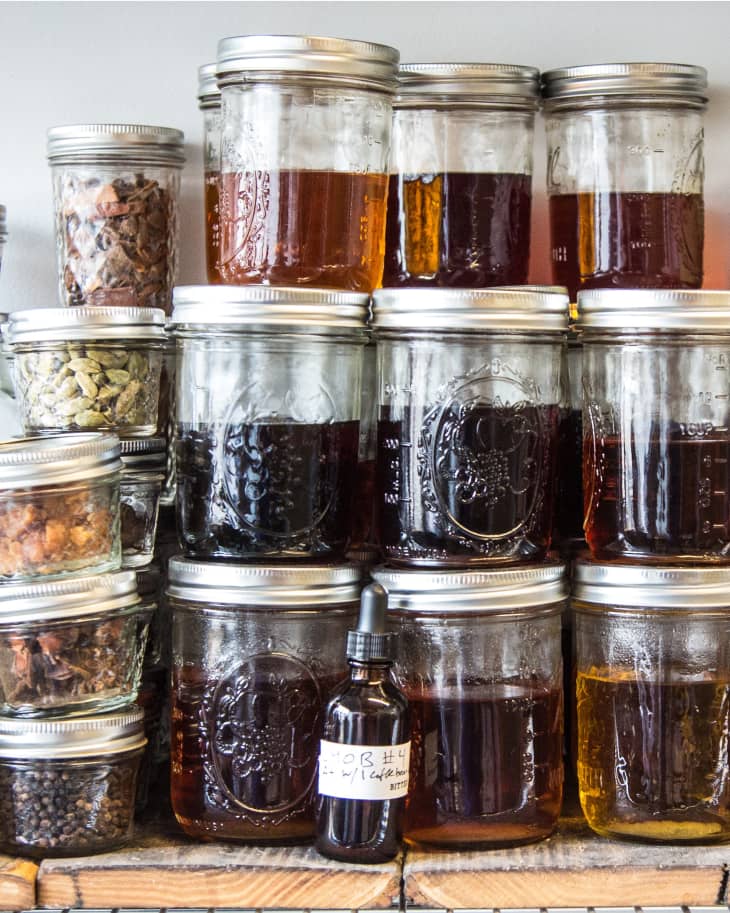How Small-Batch Bitters Are Made
If you’ve bellied up to a craft cocktail bar lately, you’ve likely noticed little bottles of concentrated spirit-and-botanical infusions adorning the bar top. These are homemade bitters, and they’re not so hard to make.
These bitters are often the handiwork of the team behind the bar — and they run the gamut from the very versatile for a broad array of drink recipes, to very specific and esoteric flavors suited to just one or two drinks. If you’d also like to try your hand at making homemade bitters, read on for some pro tips and an inside look at how one company is making small-batch bitters.
Why Make Your Own Bitters?
As interest in classic and newly conceived modern-style cocktails has come on strong, professional and at-home bartenders alike have recognized the need to accent those drinks with pungent, flavorful bitters. That same resourceful lot has taken to concocting varieties of bitters for themselves. This gives not only a sense of accomplishment, but also the ability to get seriously creative with flavors.
Get Instructions for Making Bitters at Home
Small-Batch Commercial Bitters Are Also Having a Moment
In the column’s coverage of orange bitters this month, we wanted to spotlight the groundswell of grassroots, DIY activity that has helped immensely to drive the regrowth of the bitters market in recent years.
To do so, we caught up with the guys behind the New York City bitters startup Hella Bitter.
Numerous small outfits having recently entered the business of bitters. Hella Bitter, a venture by friends and colleagues Tobin Ludwig, Eduardo Simeon, and Jomaree Pinkard, is among the standout upstarts; earlier this month Liquor.com ranked Hella Bitter No. 1 in a roundup of locally made bitters in the U.S.
What Ingredients Go Into Bitters?
Hella Bitter uses whole spices, fresh citrus fruit, and high-proof grain spirit to produce its two varieties: a citrus bitters, and an aromatic bitters.
The process itself is straightforward; what’s tricky about making bitters is knowing when to say when.
“Ingredients go through a 30-day cold maceration period where the spirit acts as a solvent,” Simeon said, “extracting flavor and essence from the botanical ingredients.”
Hella Bitters bundles the botanicals into big spice bags, and they take out ingredients one by one over time, based on how quickly a given flavor comes forward during the maceration process. That’s the tricky bit, as some botanicals give up their essence faster than others.
After the botanicals have infused the liquor, they’re removed and they filter the liquid. At that point, the team adds homemade caramel syrup to impart sweetness and color, Simeon said.
The brand’s citrus bitters include a number of botanical ingredients, though cardamom and grapefruit are among the most prominent, Simeon said. “These are not the main botanical ingredients by volume but they certainly come forward nicely and keep the overall flavor profile complex and exotic.” Simeon estimated that the team had gone through “roughly two dozen” test recipes before they arrived at the current blend.
Where Hella Bitter Buys Spices for Their Bitters
In the years they’ve been in business, Hella Bitter has grown and altered its network of spice suppliers. “Today we have several trusted sources that we tap on a case by case basis depending on the ingredients and seasonality,” Simeon said. “Oddly enough, even dry goods have an on and off season. We do our best to capture them at their peak quality and price.” For quick-turnaround sourcing and for procuring small quantities of raw materials for R&D, they often rely on Kalustyan’s, the Manhattan market and spice emporium.
How They Get Inspiration
As part of their product development, they’ve pored over many a classic cocktail manual, such as Jerry Thomas’ Bartenders Guide: How To Mix Drinks. “One place in particular where we looked to the past for inspiration was in our blend of bittering agents — or the barks and roots that make bitters so astringent,” Simeon said. “Gentian (an extremely bitter substance) is widely applied in potable amaros, but we also wanted to learn about dosage in wormwood bark and angelica root.”
A Few Tips for Making Bitters at Home
What advice do they have for the aspiring amateur bitters maker? “We think the best approach in flavor development is to always consider the desired application before selecting your flavors and ratios,” Simeon said. “Think about how you want to use your bitters in your own bar and kitchen and build out from there. If your goal is to make a widely applicable bitters, look to ingredients that are universally used in cooking and beverages like cinnamon, almond, vanilla, lemon, or pepper.”
If, say, you’re after a more arcane flavor profile, “Then start by keeping the recipe very simple and only choose secondary ingredients that are not going to overpower the nuance of your core focus,” he added. “Figs come to mind. A small amount of clove might bolster the delicate figgy-ness but could easily mask it if used too heavy handedly.”
If you’re not quite ready to start from scratch, but still want to try making your own bitters, check out Hella Bitter’s bitters kit. The team launched a successful Kickstarter campaign to fund a long-held dream of theirs to create a bitters-making kit that could be sold at retail. The kit includes spice mixes, jars for infusions, strainers, and, of course, a few of those little dropper bottles to hold your finished product. Just like the ones at the cocktail bar.
